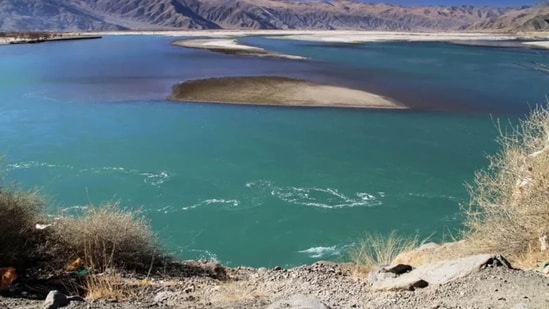In December 2024, China announced plans for what could become the world’s largest hydropower project, the Medog Dam, on the Lower Yarlunguzangbo River, known as the Brahmaputra in India. This announcement was far from unexpected. For years, this dam blueprint has been circulating through Chinese policy circles, think tanks, and five-year plans. However, the transition from concept to implementation has raised eyebrows. Is this just evidence of China’s growing ambitions, or are we witnessing the possible onset of a geopolitical storm?
 premium
premium China’s reasons for pursuing this huge project are multifaceted, and official documents often highlight three key priorities:
First, there is Beijing’s ambition to tackle the climate crisis through an aggressive shift to renewable energy. President Xi Jinping’s 2020 pledge to achieve carbon neutrality by 2060 remains a central pillar of China’s energy strategy. The dam, which will generate 300 billion kilowatt-hours of electricity annually, is being constructed as essential to achieving that goal. It is the jewel in China’s renewable energy portfolio, complementing solar, wind and nuclear power. For Beijing, hydropower is more than just energy. It is a statement of commitment to the environment, especially in regions like Tibet that have traditionally relied on small-scale projects.
Secondly, there is the problem of Tibet itself. The Tibetan Plateau, an area of enormous cultural and ecological significance, represents an area that Beijing is keen to modernize and stabilize. The government’s 14th five-year plan emphasizes Tibet’s economic belt, emphasizing high-tech industry, resource utilization and clean energy. The dam fits seamlessly into this vision and promises to drive economic growth and urbanization. For China, infrastructure serves not only as a catalyst for economic development but also as a means to assert dominance in politically sensitive regions.
Finally, there is the strategic element. China sees the dam as a way to maximize the use of the river’s resources before water flows to neighboring countries such as India and Bangladesh. With no cross-border water-sharing agreements in place, this approach underscores Beijing’s policy of acting decisively to secure its own interests. A report from a Chinese think tank openly highlights the need to outperform downstream hydropower competitors and address Asia’s growing water shortages.
On paper, the project seems perfectly aligned with China’s ambitions. But reality is rarely that simple.
Yarlung Zangbo’s unique geography is both a blessing and a curse. Its steep slope offers unparalleled potential for hydroelectric power generation, but places the proposed dam in an area of heavy tectonic activity. Earthquake risks are well-documented and Chinese authorities have assured that decades of geological research have deemed the site safe, but experts say even minor miscalculations could lead to catastrophic It warns that this may lead to serious failure. And this is not just China. Downstream countries like India and Bangladesh will bear the brunt of any disaster.
Compounding these concerns is China’s long-standing difficulty engaging in meaningful dialogue with its neighbors on water management. Beijing shares limited flood season data with India, but the lack of a comprehensive agreement stokes mistrust. For India, the Brahmaputra is a lifeline for millions of people, especially in Assam and Arunachal Pradesh, where sudden water release or long-term retention can have devastating consequences. For Bangladesh, changes in sediment flows could disrupt agriculture and livelihoods in ways the nation cannot afford to ignore.
Not all voices in China agree with the government’s approach. Some researchers have warned that unilateral megaprojects on shared rivers could backfire environmentally and diplomatically. The 2022 Tsingua University report called for transparency and cooperation to ensure regional stability, but such advice continues to be overlooked, highlighting the gap between academia and policy .
India, in its part, does not stand idly by. The dam construction initiative in Arunachal Pradesh is a clear response to China’s actions. But this Tat approach risks escalating tensions rather than resolving them. Without a shared vision for the future of the river, the Brahmaputra could become a source of life and a battlefield.
The stakes cannot be higher than they are now. Already strained by the climate crisis and unchecked developments, water security is a growing challenge of our time. The future of the Brahmaputra will shape not only the lives of people along the bank, but the stability of South Asia as a whole. Global institutions like the United Nations must act now to foster dialogue and prevent a hydropolitical crisis.
This isn’t just a story about dams, it’s about choices. China has an opportunity to make Yarlung Zangbo a symbol of shared progress. However, unilateral outcomes can have dire consequences. More than just a river, the Brahmaputra is a lifeline for millions of people. Its management today will define the region’s future. Will China seize the moment to cooperate?
This article is written by Hriday Sarma, a senior fellow at the South Asia Democratic Forum in Brussels.


